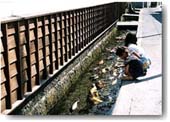The impressive spots in Shimabara
The impressive spots in Shimabara
|
The history of Shimabara, as a castle town, begins in 1618, when daimyo (feudal lord) Matsukura Shigemasa started the construction of the Shimabara Castle. The castle was completed after more than seven years, and was inhabited by many subsequent generations of the daimyo.Thus, Shimabara came to be the administrative and economic center of the peninsula.
|
 |
Shimabara Castle
Daimyo Matsukura Shigemasa applied all of his castle-building expertise to the construction of this flatland-style castle. The castle is now in use as an educational and cultural facility that houses a collection of Christian relics, the Kitamura Seibo Museum, a museum dedicated to the revival of tourism, and a collection of folk artifacts . |
 |
The old samurai street
A street lined with stone walls and a spring water canal running down the center commemorates the old samurai section of Shimabara. Three samurai houses have been restored and opened as exhibits. |
 |
Statue of Buddha entering Nirvana
The shining silver statue of Buddha as he continued to preach up to the very moment of his entrance into Nirvana commemorates his last holy moments. (8.6 meters long and 2.12 meters high.) |
 |
Remains of the old Shimabara province herbal garden
In 1834, Matsudaira Tadanari, then feudal lord of Shimabara, created a garden devoted to the cultivation of medicinal herbs. It is the largest and most comprehensive of such remains in Japan. |
 |
Honkoji temple
The family temple of the Matsudairas, feudal lords of Shimabara. Stone statues of the 16 Rakan deities and a statue of the Bodhisattva nyoirinkanzeon which have been designated by the city as cultural assets are enshrined in the temple . |
 |
Gokokuji temple; designated by the city as a cultural asset
In 1736, feudal lord Matsudaira Tadami commissioned thirty master woodcarvers of Kyoto to create thirty wooden painted figures which are now enshrined in Gokokuji temple. |
|
| There are fresh springs all over Shimabara, and carp swim in their pools, adding to the charm of this city of water. Many of the springs are the result of a series of eruptions of Fugen-dake (the local volcano) in 1792. Lake Shirachi, Hama-no-kawa, and Uto-deguchi are representative bodies of spring water. |
 |
City of Swimming Carp
Approximately 1,500 carp swim in the beautiful pools of this city of fish. Their forms add elegance to Shimabara, a city of fresh springs. |
 |
Hama-no-kawa Spring
This is a major spring of Shimabara that has long been used by its citizens for their daily water needs . |
|
|